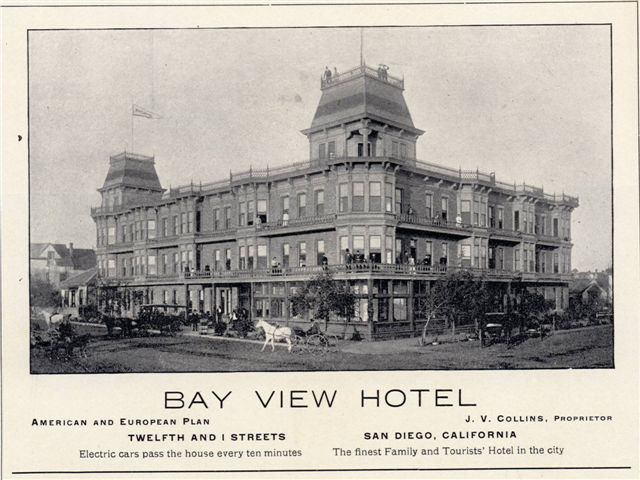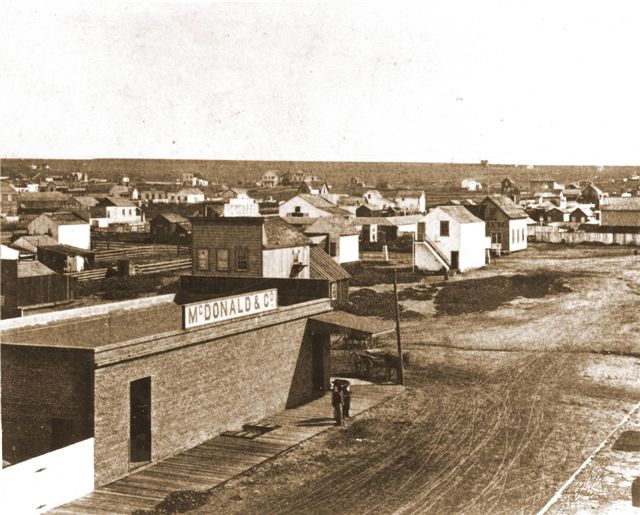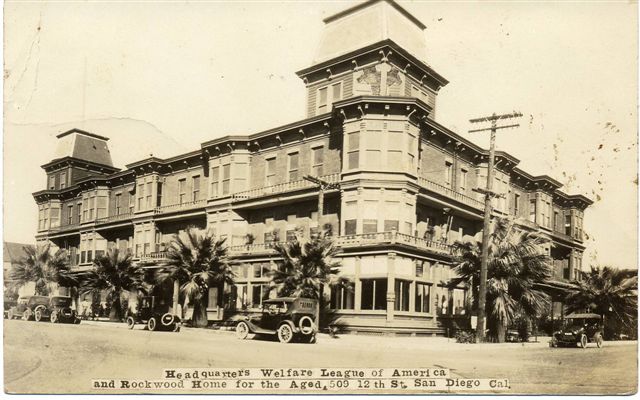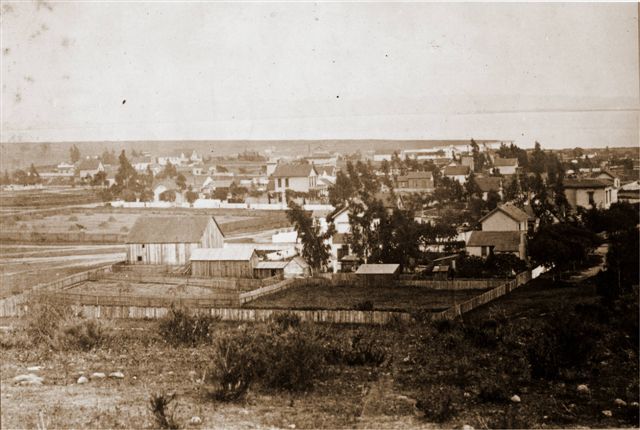The Historic Bay View Assisted Living Residences (Originally Known as the Bay View Hotel then The Palms Hotel)

The historic Bay View Hotel more recently known as the Palms Hotel and soon to be renamed The Historic Bay View Assisted Living and Memory Care Residences, located at the northeast corner of Park Boulevard and Island Street, is one of the first hotels built in Horton's new downtown San Diego. The one-time elegant hotel has, until now, endured hard times and has a colorful and sordid history of guests that have occupied the hotel.
Originally, the hotel existed as the Bay View Hotel, built in 1869 by R.D. Case, and at that time was the largest hotel in the city. It was a large Greek Revival two-story wood-frame building with a columned front porch, wood siding and steep roof lines. Also, typical of that architectural style, there were side-lights at the main entry doors, an entablature at the second-level veranda and pediment-shaped window heads. Newspaper advertisements noted that the acclaimed hotel featured 25 large, airy rooms with views of the harbor and the bay. It was also rumored to be the only hotel of its time to have lathe and plaster, perfectly dry rooms, which were furnished with spring mattresses. It had become the social center of Horton's New Town—the scene of many parties and social gatherings -- and a terminal for stage lines. Prominent businessmen used it as a stopover because of its proximity to the steamers and tourists could rent a horse and buggy and go sightseeing along the bay.

In 1887, the hotel came under ownership of proprietor Joseph V. Collins, an oil, lumber and hotel businessmen from Pennsylvania, for the purchase price of $20,000. This was also the year that Wyatt Earp and his third wife, Josie, arrived in San Diego and stayed in the second floor, corner suite of the hotel while he operated gambling saloons in the Gaslamp. Collins had a grander vision for the hotel and in 1888 decided to move a part of the original two-story hotel across the block, where it would be used as a private residence for the hotel manager, while the remainder of the original building became incorporated into a newer, larger three-story brick and wood building, covering half a city block in its place. Portions of the 1869 hotel structure can still be seen where the old building was lifted up a level to be as tall as the new three-story structure while a new ground floor was added underneath. Old photos show a part of the original pitched roof of the 1869 hotel melded into the Victorian design of the 1888 addition. The new 1888 Victorian addition featured large bay windows, galleries for outdoor promenades which extended along the second and third floors, and two towers—done in the French Second Empire architectural style and located at the north and south ends--provided sitting rooms where guests could sit and enjoy the panoramic views of Point Loma and Coronado Island. (The towers and third floor promenade would later be removed or destroyed and are not seen today.) The hotel had other notable Victorian details to accentuate the long facades such as Italianate cornices, brackets at the roof overhangs, friezes, ornate window moldings and string courses. The main entrance to the hotel, off of Park Boulevard (then 12th Avenue), was accessed adjacent to the large first-floor veranda and opened to a spacious lobby and rotunda. A large sweeping staircase lead guests up to the additional floors, and eventually, to a single skylight that pours light down to the lobby below. The 150 rooms, if one were to count the adjacent sleeping alcoves behind the parlors as additional rooms, had high ceilings, transoms above the doors to allow light in at all times of day, and heating and lighting by means of gas and electric bells, which signaled to the office below. Other notable rooms in the hotel were a reading room, smoking and writing room, dining room, and ladies' room. The hotel even had its own complete printing office, capable of putting out newspapers, where the bills of fare for each meal served in the elegant restaurant would be printed. By the end of 1889, the magnificent Victorian hotel was open and ready for business. It soon became very popular as a destination place and famous for its first-class cuisine—tourists and guests were served the finest in drink and could lunch on calf's tongue and other viands.

Collins passed away in 1913, and in 1923 the hotel was renamed the Palms Hotel because of the queen palms that lined the street. According to an article in the San Diego Union, in 1923 Mr. and Mrs. J.M. Ray, who had run a home for the aged in Pacific Beach, purchased the Bay View, which had previously been renamed the Palms, and operated it as an assisted living facility known as the Rockwood Home for the Aged at the Palms. Mr. and Mrs. Ray got into financial and legal difficulties when they solicited large upfront payments from seniors with the promise of lifelong care. In 1927 ‘inmates’ of the Palms Hotel for the Aged (as they were called) began complaining of financial irregularities. In November Mrs. Ray answered a subpoena to testify to the grand jury, and while she was at the courthouse waiting to be called, she was arrested for violating state wage laws. Meanwhile, the county welfare board heard from inmates that the Rays had collected $13,260 so far this year for life memberships. Nine men and women said they had paid from $1000 to $3000 each for a home and care for the remainder of their lives but were left stranded when the Rays left the place.  The Rays were unable to make their payments on the mortgage, the hotel was sold at auction in March 1928, and the remaining inmates were turned out on the street. The grand jury returned indictments against the Rays for grand larceny, embezzlement and obtaining money under false pretenses, but in three separate trials over the next few months none of the charges stuck; some were dismissed, others resulted in mistrials, they were acquitted on some charges, and Mrs. Ray’s appeal of her two convictions was upheld by an appellate court.. The Rays were unable to make their payments on the mortgage, the hotel was sold at auction in March 1928, and the remaining inmates were turned out on the street. The grand jury returned indictments against the Rays for grand larceny, embezzlement and obtaining money under false pretenses, but in three separate trials over the next few months none of the charges stuck; some were dismissed, others resulted in mistrials, they were acquitted on some charges, and Mrs. Ray’s appeal of her two convictions was upheld by an appellate court..
In 1929, the state Supreme Court overturned Mrs. Ray's appeal and, faced with yet another trial, she pleaded guilty to the embezzlement of funds from an elderly man for whose estate she had been appointed guardian and spent time in jail.
It was the misfortune of the elderly people swindled by the Ray's but a large benefit for the conversion of the property now into an assisted living/memory care facility. The California State Historic Building Code allows an owner to go back to any lawful use of the property that had existed in the past. The Rockwood Home for the Aged now allows the owners to operate the project as proposed without the need for any zoning variances.

Not much is known or documented about the hotel after the Ray's departure until 1972, when the aging hotel, and a faint reminder of what life was like in Harbor City, was purchased for $200,000 by a group of developers. Although they had intentions of restoring the hotel to its former glory, nothing was done to improve, let alone upkeep, the hotel. It had fallen into disrepair and became a tenement house, with 76 rooms, for people down on their luck. In 1979, the movie, A Force of One, starring Chuck Norris, was filmed at the hotel. In the movie, a junkie runs up the winding staircase and bangs on one of the doors, yelling "Where's my fix?" - something that probably wasn't too out of the ordinary at that time, and up to the current time when the hotel was purchased by one of Mr. Shapery's companies, 12th & "A" Hotel Partners, LP., on July 17, 2010. The first order of business was the removal of no less than 11 tenants who were known to be selling drugs while occupying rooms in the Palms, much to the pleasure of the San Diego Police Department. With the current revitalization of the East Village and its close proximity to Petco Park, the new Thomas Jefferson law school across the street, and the new public library, the dilapidated Palms Hotel will once again be restored to its former glory.
The property will be completely renovated and upgraded in preparation for its operation as an 83 suite assisted living and memory care facility. Contemplated improvements include the addition of a caged, period elevator along with a conventional second elevator for the convenience of residents, bathrooms and kitchens in every suite, and a completely new electrical and mechanical/air conditioning system. All original wood trim will be restored and materials that cannot be restored will be replaced with correct replicas. The original door locks will be replaced with the latest card reader system. All furnishing will be period designed pieces based upon original photos.
A restaurant will be reintroduced on the ground floor in addition to the replacement of the two towers that once occupied the corners of the roofs, plus the addition of 1500 sq. ft. of rooftop public area. Sometime during the hotel's history the top floor of the original building, along with its pitched roof, was removed purportedly due to a fire. That portion of the third floor will be reconstructed to its original design.
Upon completion of the contemplated improvements, the historic Bay View Hotel will be renamed The Historic Bay View Assisted Living Residences, will once again become a prominent place in downtown San Diego that will allow one to relive the experiences of the past in the new downtown San Diego.
|
